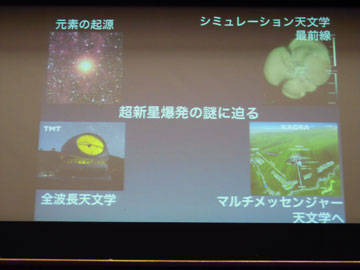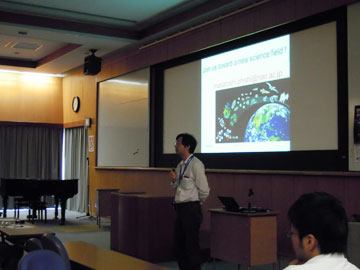[Speaker 1]
Katsuya Hashizume
[Title]
The outflow from accretion disk around the Black Hole
[Abstract]
The accretion disks around Black Holes(BHs) are believed to drive high energy astrophysical phenomena , such as high-energy radiation, disk outflows, and jets of Active Galactic Nuclei and black hole binaries.
But, structure of the disks and mechanisms of driving outflow have poorly understood. Especially, super-Eddington accretion disks, of which luminosity exceeds the Eddington luminosity, is a hot debated issue.
If the super-Eddington disks are feasible, the ultra luminous X-ray sources are explained without assuming intermediate mass black holes.
By two-dimensional radiation-hydrodynamics (2D-RHD) simulations, super-Eddington accretion disks around BHs are successfully reproduced, implying that quasi-steady super-Eddington accretion is possible (Ohsuga et al. 2005).However, the computational domain of the simulations is restricted tobe 500 Rs (Schwarzschild radius).Thus, the behavior of outflows at the distant region (>500Rs) is not investigated.
The structure of the super-Eddington flows might change if the outflowing matter of >500Rs get back to the vicinity of the black hole.
In order to understand more realistic structure and dynamics of the super-Eddington flows, it is needed to reperform 2D-RHD simulations with much larger computational domain.
In this talk, I present the fundamental mechanisms of BH accretion disks and outflows,and also my research plan of master thesis.
————————————————————
————————————————————
[Speaker 2]
Daehyeon Oh
[Title]
Finding Brown Dwarfs in star formation region with subaru telescope
[Abstract]
TBD
年別アーカイブ: 2012年
国立天文台特別公開講座/総研大天文科学専攻入試ガイダンスを開催
2012年5月26日に(土)に国立天文台(三鷹キャンパス)で、特別公開講演および総研大入試ガイダンスが行われました。今年は、30名以上の方々にご参加いただき、大変な盛り上がりを見せました。また、学生のみならず一般の方も参加され、日本の天文学を国立天文台から社会に発信する良い機会になりました。
特別公開講演では、「新領域を切り開く天文学」をテーマとして、ハワイ観測所の宮崎聡准教授、理論研究部の田中雅臣助教、天文データセンターの大石雅寿准教授による公演が行われました。装置開発からシミュレーションに至るまで最先端の研究を身近に感じられ、参加者にとって大変有意義な時間となりました。また、参加者による質疑応答では、今後日本の天文学がどのように発展して、どんな可能性を秘めているのか、白熱した議論が繰り広げられました。
教員との相談会では、興味・関心のある分野の教員に直接話を聞くことができ、大学院の概要,入試や入学後の学生生活,実際の研究活動などの質疑応答が活発に行われました。また、院生とも交流する場が設けられ、実際の研究生活や、授業、実習などについて詳しく聞けるとても有意義な場となりました。このように、多くの方々にご参加いただけたことで、積極的な質疑応答が交わされ、参加者にも講演者にも大変意義のあるガイダンスとなりました。
 田中助教の講演内容
田中助教の講演内容
 参加者から質問を受ける大石准教授
参加者から質問を受ける大石准教授
 教員との相談会の様子
教員との相談会の様子
 ハワイからもskypeで接続して対応
ハワイからもskypeで接続して対応
Investigating the coevolution between SMBHs and Galaxies at z~3 / Morphological Evolution of Passively Evolving Early-type Galaxies at z~2
[Speaker 1]
Yuriko Saito
[Title]
Investigating the coevolution between SMBHs and Galaxies at z~3
[Abstract]
In the local universe, there is a tight correlation between the masses of super massive black holes (SMBHs) and stars in the spheroidal components (bulge and elliptical galaxies), suggesting that their formation is physically closely related. Various models assuming different physical mechanisms are proposed to explain the observational result at z=0.
Since these models predict different redshift evolution of the SMBH-spheroid mass ratio, it is important to observationally constrain the mass ratio at high redshift. Since the predicted difference becomes larger at higher redshift, going to higher redshift is better to distinguish among these models, but at the same time observational difficulties increase at higher redshift.
By taking into account these factors, we have concluded that z=3-3.5 is the best redshift range.
However, previous studies have mostly been limited to z<2.
We have embarked on (1) systematic near-infrared spectroscopy of z=3-3.5 QSOs, to derive the SMBH masses, based on the the Balmer beta emission line width and nearby continuum luminosity, using 3--4m telescopes, and (2) Subaru LGS-AO near-infrared multi-color imaging observations, to estimate spheroidal stellar masses in the host galaxies of these QSOs.
The use of Balmer beta line, PSF-stable Subaru LGS-AO, and multi-color imaging data make our study the most reliable and promising to investigate the redshift evolution of SMBH-spheroid mass ratio and to observationally constrain the physical mechanism behind the correlation.
In this talk, I will present our strategy and current progress of this project.
------------------------------------------------------------
------------------------------------------------------------
[Speaker 2]
Sumire Tatehora
[Title]
Morphological Evolution of Passively Evolving Early-type Galaxies at z~2
[Abstract]
Understanding the formation of massive elliptical galaxies is an unsolved problem. The discovery of a widespread population of passively evolving early-type galaxies (ETGs) at z>1.4 have proved that quenching star formation in most massive galaxies was well under way by z~2. And such objects are extremely compact, having much smaller effective radii compared to local ETGs with the same stellar mass, while massive ETGs
with similar effective radii have also been found. If we understand their dynamical and structural properties in detail, it is important to measure the stellar velocity dispersion of galaxies. However the number of high-z ETGs with measurement of the velocity dispersion is still extremely small.
So we have deep NIR spectroscopic observations of 33 massive passive BzK-selected galaxies (pBzKs) from the COSMOS field using Subaru/MOIRCS. In this talk, I will present progress of an analysis.
Surveys for Lyman Alpha Blobs at z=2 and 3 / Infrared Linear and Circular Polarimetry of the NGC 6334 Star Forming Region
[Speaker 1]
Takatoshi Shibuya
[Title]
Surveys for Lyman Alpha Blobs at z=2 and 3
[Abstract]
LyA blobs (LABs) are mysterious extended sources at z ~ 2-6. Because LABs are thought to closely relate to the formation of / the feedback from massive galaxies, investigating the origin of their brightness and spatial extent is quite important. However, despite intensive observational and theoretical approaches, the formation mechanisms of LABs have been poorly constrained. In order to understand their hidden total energy budget and relationship with other galaxy populations, such as compact Lyman Alpha Emitters (LAEs) or massive Sub-Millimeter Galaxies (SMGs) selected by using various wavebands, surveys for LABs in well-observed fields in multi-wavelengths are crucially required.
For this purpose, we have undertaken narrow-band imaging surveys in 2 MUSYC fields, the Extended Chandra Deep Field-South and the Extended Hubble Deep field-South, for LABs at z=2.1 and 3.1. In this presentation, I will provide our preliminary results.
————————————————————
————————————————————
[Speaker 2]
Jungmi Kwon
[Title]
Infrared Linear and Circular Polarimetry of the NGC 6334 Star Forming Region
[Abstract]
Magnetic fields have been thought to play a crucial role in regulating accretion onto protostars, both in powering and shaping outflows and removing angular momentum from disk material, to allow the protostar to gain mass. However, the precise role of the magnetic field is poorly understood and evidence for its shape and structure has not been forthcoming. Getting evidence for the morphology of these fields has been tricky though – and this is an area in which polarimetry can help. In particular, circular polarization can provide evidence for changing grain/field alignment directions along the line-of-sight and hence the presence of twisting fields. However, the observational database of circular polarimetry in star forming regions is still very small. In this presentation, we present deep linear and circular polarization images of the NGC 6334 massive star-formation complex observed in the near-infrared bands.
Preliminary study on the characteristics of polar faculae / Searching for Planetary Mass Objects in Taurus Molecular Cloud
[Speaker 1]
John K Anjali
[Title]
Preliminary study on the characteristics of polar faculae
[Abstract]
TBA
————————————————————
————————————————————
[Speaker 2]
Takuya Suenaga
[Title]
Searching for Planetary Mass Objects in Taurus Molecular Cloud
[Abstract]
A large number of substellar-mass objects isolated in star forming regions are now known, with masses ranging from those of brown dwarfs (BDs) to Planetary Mass Objects (PMOs). However, it is not well known the frequency of these objects or how they are formed. We have conducted deep i’, z’ observations toward the Taurus molecular cloud.
Based on the color selection, we have first found PMO candidates in Taurus. After planning spectroscopic follow-up, if these are confirmed to be YSOs and low effective temperature, we can suggest that the Initial Mass Function in Taurus continues into the planetary mass.